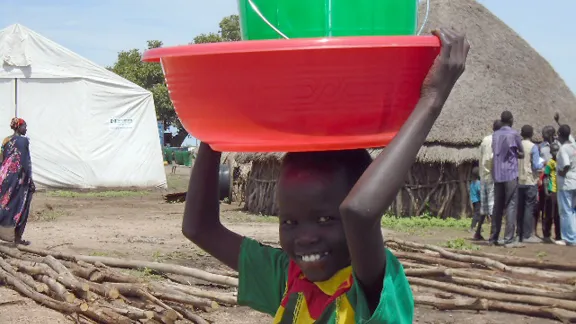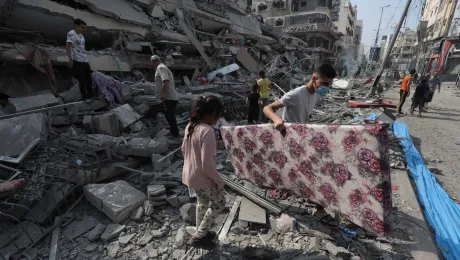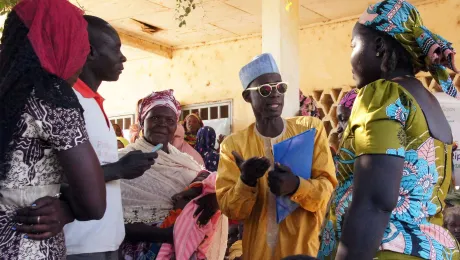
A young boy collects buckets for washing and water transport at the LWF distribution point in Leitchuor camp. Photo: LWF Ethiopia/ Heidi Lehto
“Emergency Within an Emergency”
(LWI) – The aerial view of Leitchuor refugee camp in Ethiopia’s Gambella region is devastating. It resembles a big lake, dotted with little islands of white tents peeking out of the water. Standing on muddy earth, the camp looks even worse. There is hardly a dry spot in the place which is home to almost 50,000 people, many of them refugees of the recent conflict in South Sudan. More than 200,000 have fled to the region since the conflict started one year ago.
On 17. November 2014 UNHCR and the Ethiopian government started relocating refugees from the flood-prone Gambella region to a new site named Pugnido. It is planned to also relocate 70 percent of the Leitchuor population to this site.
Extreme flooding has tested the refugee camps of Leitchuor and NipNip in Ethiopia for months. In August, heavy rains caused havoc by flooding Gambella, inundating Leitchuor camp and destroying the infrastructure. Further destruction followed a month later when the Baro river burst its banks. With roads engulfed by water, the essential delivery of life saving services has been severely affected. Since the camp became cut off from the rest of the region, the area has been accessible only by UN-run helicopter and cargo boats sailing –and occasionally sinking– on the Baro river.
Focus on Water and Hygiene Promotion
“Refugees have started salvaging materials from the collapsed tukuls, while they take shelter on the elevated roads and among host communities in nearby villages and churches” Sophia Gebreyes, LWF Country Representative for Ethiopia, says.
“Their resilience in the midst of flooding is being tested in terms of constant displacement, insecurities, deplorable living conditions and diseases. Due to recent incidents claiming several lives, the refugee mothers live in constant fear that their children will drown in the flood puddles.”
Despite the numerous obstacles that have hampered the refugee operations in Leitchuor, LWF staff remains committed to improving the living conditions of the refugees with lifesaving activities such as sanitation and hygiene promotion, waste management and distribution of WASH items.
“Hygiene and sanitation promotion is a crucial part of LWF’s current activities, designed to combat the recent outbreak of hepatitis E and the increasing number of malaria cases, which are the main cause of morbidity”, Country representative Gebreyes says. Malaria prevention and control activities, including environmental management and community awareness raising, are mobilized through the Community Outreach Agents (COA).
LWF has been distributing non-food items, in total 10,000 pieces of soap, 8,000 jerry cans, 1,300 wash basins and 7,900 buckets. These items were given especially to elderly and unaccompanied or separated children, to ease their burden of eater transport and storage. LWF also handed out 65,000 sachets of water purification chemicals, received from UNHCR. Local staff provided information on water handling and purification so the material would be used properly.
End of rain means more refugees
While the end of the rainy season may relieve the flooding in the Gambella camps, it might also lead to an increase in new arrivals as fighting reignites across the border. “The warring parties in South Sudan’s civil war have used this time to organize their troops again and we fear that they are preparing for major offensives as the heavy downpours ease”, Ms Gebreyes says.
South Sudan continues to face a humanitarian crisis of major proportions. The total number of refugees who have entered Ethiopia since the outbreak of the conflict in mid-December 2013 is now over 193,649 individuals. With the number continuing to increase daily, the arrivals in the Gambella Regional State cite fighting and food insecurity as the main reasons for their flight. Although the number of daily arrivals have dropped since the rainy season commenced, dramatic increase is anticipated as the passage ways to Ethiopia become yet again accessible. With the renewed fighting in South Sudan resulting in further displace-ment, atrocity crimes and famine, more people will be forced to seek asylum in western Ethiopia.
The anticipated influx will further stretch the capacity of all agencies striving to provide basic services in this ’emergency within an emergency’. The new arrivals and those stranded in the flooded Leitchuor are facing an uncertain future, adding to the distress of the war.


